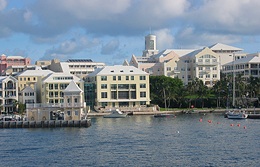Island ‘Unlikely To See Another Start-Up Wave’
 Bermuda likely has seen its last significant class of catastrophe reinsurance companies form in the aftermath of huge catastrophe losses, as simpler and cheaper alternatives have become more attractive than full-blown startups, industry journal “Business Insurance” reported recently.
Bermuda likely has seen its last significant class of catastrophe reinsurance companies form in the aftermath of huge catastrophe losses, as simpler and cheaper alternatives have become more attractive than full-blown startups, industry journal “Business Insurance” reported recently.
The island’s catastrophe reinsurance market was shaped by the forces of Hurricane Andrew in 1992, the teror attacks on the United States in 2001 and a string of costly hurricanes that battered the US in 2005.
“After each of those events, investors reacted to opportunities created by significant reductions in capacity by forming reinsurers,” said the magazine. “A large catastrophe occurring today would trigger a different reaction, market sources say, as reinsurance capacity can be put in place faster and cheaper through alternatives to reinsurer startups.”
The wave of reinsurer creations after Hurricane Andrew saw eight independent companies formed in the 1990s, most of which have been absorbed by other insurance groups.
Some of the firms have merged with other entities and “the smaller ones tended to be swallowed up,” said Michael McClane, a managing director and head of market analysis for the Americas and head of US and Bermuda research at Aon Benfield Inc.
Of that class, only RenaissanceRe Holdings Ltd. and Partner Reinsurance Co. Ltd. remain.
“After 2001, we had another wave of companies form, and that class is still broadly intact,” said Chris Klein, London-based global head of reinsurance markets for reinsurance intermediary Guy Carpenter. “Some have grown to be significant businesses. One or two smaller ones have disappeared.”
Some reinsurers formed after the 2005 storms are evolving into public companies as investors look to take profits or are combining with other companies, Mr. Klein said. “There is still at least one under original ownership,” he said.
If a major catastrophe were to strike in the near future, startup reinsurers are not as likely to form, sources said.
“The general feeling is that we would not see a distinctive class of newly licensed formations, as we have seen over the last three market-changing catastrophes,” said Mr. Klein.
“I think it would be substantially different,” said Neill Currie, co-founder, president and CEO of Renaissance Reinsurance Ltd. “We already have companies set up here that are reasonably good to very good at what they do. Unless folks think we don’t know what we’re doing, why form a new one?”
Instead, alternatives such as sidecars and collateralised reinsurance programs likely will be used as an easier, cheaper way for investors to pump capacity into the Bermuda catastrophe reinsurance market, sources said.
“Sidecars can be put together in a short amount of time,” Mr. McClane said. Because of the short-term nature of their existence, capital could be withdrawn in several years, he said.
Fully collateralized reinsurance programmes also might be more attractive than startups, Mr. Currie said.
“Those have a place,” partly because they don’t require ratings and are therefore easier and less expensive to establish than reinsurance companies, he said.
Sidecar formations have surged in recent years.
In a 2008 report, J. David Cummins, Harry J. Loman professor emeritus of insurance and risk management at the Wharton School at the University of Pennsylvania, gathered information from A.M. Best Co. Inc, Marsh Inc., Aon Benfield and other sources to show that the 2005 storm season boosted the popularity of sidecars.
The report, “The Bermuda Insurance Market: An Economic Analysis,” showed 11 reinsurance companies formed and 16 sidecars were established after the storms. Initial capital in the reinsurers amounted to $7.92 billion, while the sidecars were funded with $4.29 billion. Two of the startups, however, never underwrote any business.
No sidecars were formed when the 1993 and 2001 classes of reinsurers were formed, according to the report.
Mr. Klein pointed out that the special-purpose vehicles can be put in place without going through a rating process, unlike traditional reinsurer startups. Starting a sidecar avoids the hiring issues and distribution decisions that reinsurers are forced to make, he added.
Greg Reisner, senior financial analyst with Best, said he believes that only an extremely destructive catastrophe would spur formation of new property catastrophe reinsurers in Bermuda. “Barring a major, major event, I agree that we will see sidecars come in,” he said.
Bermuda may not see a rush to form catastrophe reinsurers, but it remains a place where that business will continue to thrive and alternatives will be developed, “Business Insurance” reported.
As a domicile with a solid infrastructure and appropriate tax rates among its selling points, “Bermuda is still a very attractive location,” Mr. Currie said. “We’ve seen people move their holding companies, but it comes down to people and preferences.”
Reinsurers more interested in the European market may lean toward a corporate base in Ireland or Switzerland, Mr. Currie said, while those aiming more for the North American market are more likely to prefer Bermuda as headquarters. Ireland and Switzerland have attractive tax rates and regulations as well as access to the European market,
“For us, Bermuda is just right,” Mr. Currie said. “Some people have been throwing rocks at it,” he said of criticism of the domicile, but its attractions make it the best choice for RenaissanceRe.

